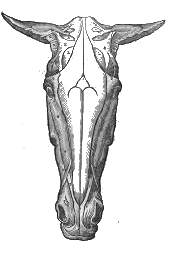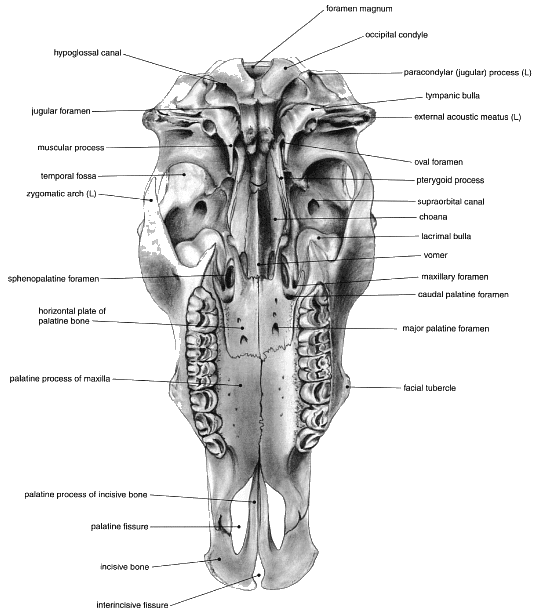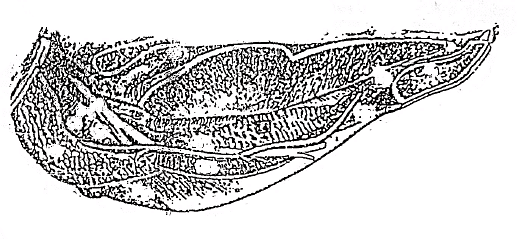UPSC Exam > UPSC Notes > Animal Husbandry & Veterinary Science Optional for UPSC > Paranasal Sinuses of OX
Paranasal Sinuses of OX | Animal Husbandry & Veterinary Science Optional for UPSC PDF Download
Sinuses
Sinuses are air-filled spaces in your skull bones, helping to shape your head without adding weight. They are either located near your nose (nasal sinuses) or around your nose (paranasal sinuses).
Types of Paranasal Sinuses
- Frontal Sinus: Largest sinus located in the forehead bone, extending towards the back of the skull.
- Maxillary Sinus: Situated in the cheekbone area, extending downward and forward.
- Palatine Sinus: Found in the horizontal part of the palatine bone and the maxilla (upper jaw).
Question for Paranasal Sinuses of OXTry yourself: Which sinus is located in the cheekbone area?View Solution
Frontal Sinus:
- Positioned in the forehead bone.
- Divided into small compartments, not directly connected to the eye sockets.
- Communicates with the nasal cavity through small openings.
- Helps protect the brain with a double-layered wall.
Maxillary Sinus:
- Located in the cheekbone area.
- Irregular in shape due to nearby teeth roots.
- Communicates with the nasal cavity and palatine sinus through openings.
- Extends downward and forward, sometimes reaching the level of the upper teeth.
Palatine Sinus:
- Situated in the horizontal part of the palatine bone and maxilla.
- Separated from the maxillary sinus by a complete septum.
- Connects to the nasal cavity through a narrow opening and to the maxillary sinus through the infraorbital canal.
Common Features:
- All sinuses are lined with a mucous membrane.
- They help regulate the volume and shape of the head.
- Serve as a cushioning layer around the skull.
- Aid in resonating sound and producing mucus to keep the nasal passages moist and clean.
Question for Paranasal Sinuses of OXTry yourself: Which sinus is located in the forehead bone and helps protect the brain with a double-layered wall?View Solution
 Fig: Skull - Frontal Sinus Exposed
Fig: Skull - Frontal Sinus Exposed
 Fig: Skull showing the Palatine and a part of the Maxillary Sinuses Postero-Lateral view
Fig: Skull showing the Palatine and a part of the Maxillary Sinuses Postero-Lateral view
 Fig: Skull-Maxillary Sihus Expcsed
Fig: Skull-Maxillary Sihus Expcsed
 Fig: Parotid and Submaxillary Salivary Glands, Socio-parotitis and Parotid Duct
Fig: Parotid and Submaxillary Salivary Glands, Socio-parotitis and Parotid Duct
 Fig: Left Submaxillary and Sublingual Glands, and Mandibular Duct
Fig: Left Submaxillary and Sublingual Glands, and Mandibular Duct
The document Paranasal Sinuses of OX | Animal Husbandry & Veterinary Science Optional for UPSC is a part of the UPSC Course Animal Husbandry & Veterinary Science Optional for UPSC.
All you need of UPSC at this link: UPSC
FAQs on Paranasal Sinuses of OX - Animal Husbandry & Veterinary Science Optional for UPSC
| 1. What are sinuses? |  |
Ans. Sinuses are air-filled cavities located in the bones of the face and skull. They are connected to the nasal cavity and lined with mucous membranes. The sinuses play a role in humidifying and filtering the air we breathe and also contribute to the resonance of our voice.
| 2. How many types of paranasal sinuses are there? |  |
Ans. There are four types of paranasal sinuses: frontal sinuses, ethmoid sinuses, sphenoid sinuses, and maxillary sinuses. These sinuses are named after the bones in which they are located.
| 3. What is the function of paranasal sinuses? |  |
Ans. The paranasal sinuses have several functions. They help reduce the weight of the skull, provide insulation for the eyes and teeth, produce mucus to moisturize the nasal passages, and enhance voice resonance. They also act as a shock absorber for the head, protecting the brain from injury.
| 4. How do sinuses get affected or infected? |  |
Ans. Sinuses can get affected or infected due to various factors such as allergies, viral or bacterial infections, nasal polyps, or a deviated septum. When the sinus openings become blocked, mucus accumulates, creating an ideal environment for bacterial growth. This can lead to sinusitis, causing symptoms like facial pain, congestion, and headache.
| 5. How can sinus problems be treated? |  |
Ans. Treatment for sinus problems depends on the cause and severity of the condition. Mild cases may be managed with home remedies such as saline nasal irrigation, steam inhalation, and over-the-counter decongestants. In more severe cases, antibiotics may be prescribed to treat bacterial infections. In certain situations, surgery may be needed to remove blockages or correct structural issues. It is best to consult a healthcare professional for an accurate diagnosis and appropriate treatment plan.
Related Searches




















